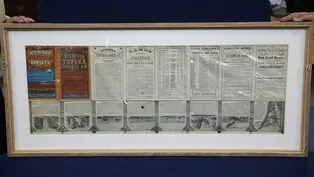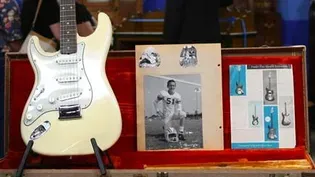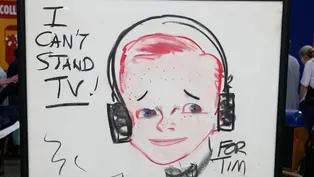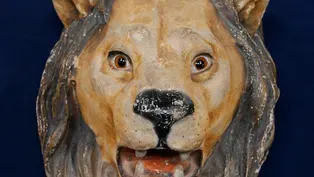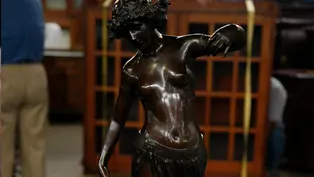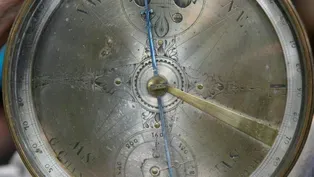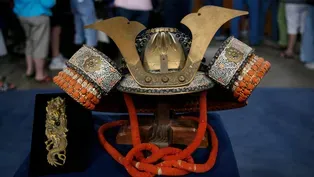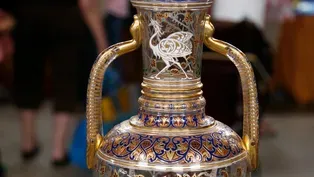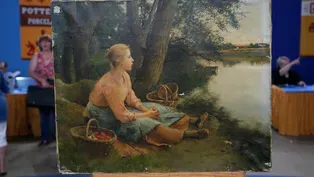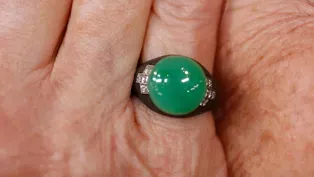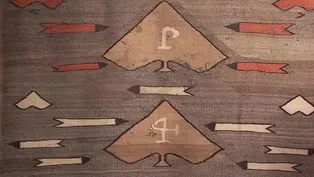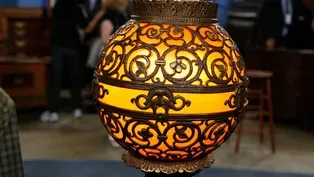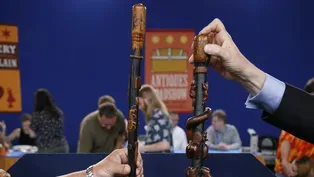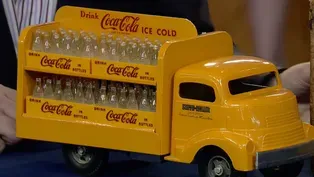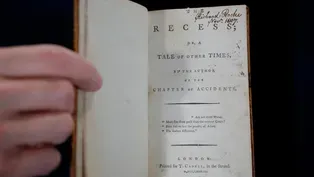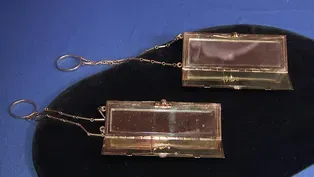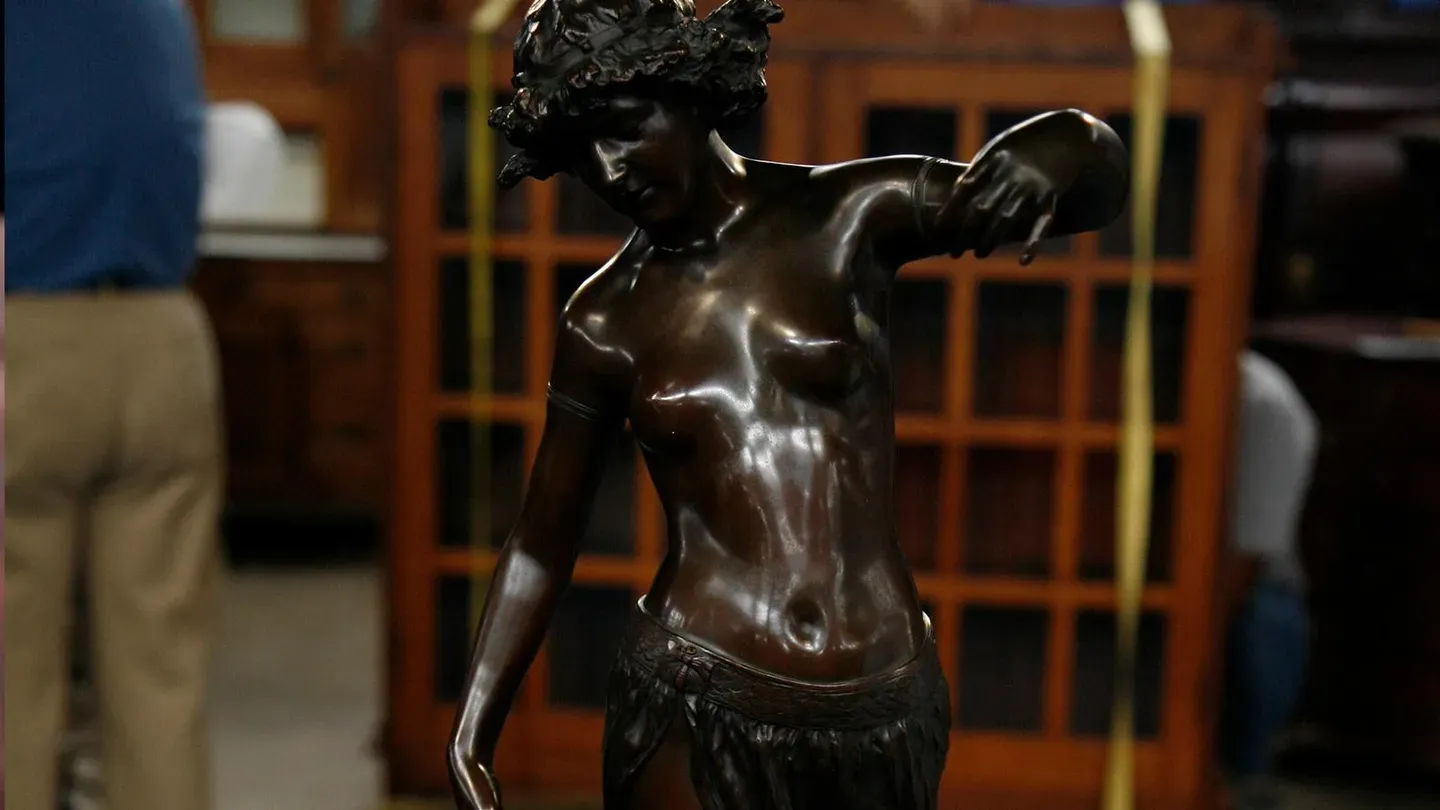

Vintage Wichita
Season 25 Episode 14 | 52m 30sVideo has Closed Captions
What are Wichita treasures from 13 years ago worth today? One’s now appraised for $55K!
What are wonderful Wichita treasures from 13 years ago worth today? Discover updated appraisals such as an Edward Onslow Ford bronze, a 1962 left-handed Fender Stratocaster, and Goldsmith Chandlee surveyor's compass from around 1790. One is now $55,000!
Problems with Closed Captions? Closed Captioning Feedback
Problems with Closed Captions? Closed Captioning Feedback
Funding for ANTIQUES ROADSHOW is provided by Ancestry and American Cruise Lines. Additional funding is provided by public television viewers.

Vintage Wichita
Season 25 Episode 14 | 52m 30sVideo has Closed Captions
What are wonderful Wichita treasures from 13 years ago worth today? Discover updated appraisals such as an Edward Onslow Ford bronze, a 1962 left-handed Fender Stratocaster, and Goldsmith Chandlee surveyor's compass from around 1790. One is now $55,000!
Problems with Closed Captions? Closed Captioning Feedback
How to Watch Antiques Roadshow
Antiques Roadshow is available to stream on pbs.org and the free PBS App, available on iPhone, Apple TV, Android TV, Android smartphones, Amazon Fire TV, Amazon Fire Tablet, Roku, Samsung Smart TV, and Vizio.
Buy Now

ANTIQUES ROADSHOW 2025 Tour!
Enter now for a chance to win free tickets to ANTIQUES ROADSHOW's 2025 Tour! Plus, see which cities we're headed to!Providing Support for PBS.org
Learn Moreabout PBS online sponsorship♪ ♪ WOMAN: I never got to play with them.
I mostly got to rock them.
I'm glad that she wouldn't let me play with it.
Hoo-rah.
(chuckles) Wow, I wasn't expecting that at all.
(laughing silently): Are you serious?
♪ ♪ CORAL PEÑA: Season 13 saw "Antiques Roadshow's" first flight to the air capital of the world: Wichita, Kansas.
People from across the Midwest took planes, trains, and automobiles to learn about their family finds and prized purchases.
Many left our Wichita Roadshow flying high, but how have the skies fared since then?
Fasten your seatbelts as we depart for this new view of Wichita.
WOMAN: My great-grandmother purchased this on a trip to Germany.
She was born and raised in Germany, and had gone back there in the early 1930s and bought this statue, uh, paid 160 marks for it back in 1931.
And it's always been in her house, and I've always admired it.
When she passed away, it went to my grandmother.
And when she died, it went to my mom.
Now it's in, proudly adorning my house.
Oh, right.
Looks like she did quite a bit of purchasing on that trip.
Was it all art and antiques, or this record everything?
Um, jewelry, a lot of knickknacks and pictures and frames.
And we still have some of those pieces, but this is the most beautiful thing I've ever seen.
I just absolutely love this statue.
Oh, it's quite, quite wonderful.
I'll turn it a little bit so we can look at the signature.
The artist is Edward Onslow Ford, who was a British sculptor born in the 1850s, and had a relatively short life; he died in 1901.
Okay.
He spent most of his career, uh, in Britain.
Um, though he did study in Antwerp and also in Munich.
And one of the things that really, um, attracted me to it when I, when I saw it at the table is, if you look at the fabric of the skirt, it really looks like it's moving, doesn't it?
Yes, yeah.
As she spins around, it's almost like it's swirling out.
And it's just really beautiful quality.
Cast in bronze, uh, probably in the 1880s.
It has a wonderful, um, dark brown patina to it.
Mm-hmm.
It's really in very good condition.
Ford was a well-known sculptor in his own day, and is very well regarded today.
At the time, he did large monuments for public places.
Seemed to have had the forethought to, um, also offer those as small reductions in more of a household size at the time.
Oh, okay.
Um, he's also known for genre scenes, sort of these young, attractive women in various poses.
But, you know, it is really such a beautiful-quality piece, and we don't see an awful lot of British sculpture on the market.
And certainly, most of what we see in this type of material is French.
So it's a very nice treat to see British sculpture, particularly of this quality.
Do you know how many of these he did?
With bronzes, it's really-- unless it's a numbered edition, it's very hard to know.
My assumption is probably dozens.
Oh, okay.
It wasn't something that was a mass production.
Mm-hmm.
And it's quite a compelling figure.
For insurance purposes, I would think in the $20,000 range.
Wow.
Wow.
So definitely something to take good care of.
That's wonderful.
That's wonderful.
Thanks for bringing it in today.
Thank you very much.
Well, Bruce, when I saw this spectacular image when you walked in, I was very pleased, 'cause it's a wonderful thing.
But before we talk about this particular image, what I'm gonna do is what it tells us here.
"Read the outside of this folder."
So, I'm gonna turn this around.
And this looks pretty strange, compared to the other side.
Can you tell us what this is?
This is a Atchison, Topeka, and Santa Fe Railroad time schedule dated 1876.
Right, so it folded up, and those are the covers.
And tell me what it's got on here.
Well, it glorifies the railroad and coming to the West.
It gives the time schedules here on the top.
It is also selling land, because they owned land, the railroad.
And down here, you could buy land from them.
Let's flip it again, we'll go this way this time.
There we go.
Down here we have the dugout house, and your ancestor lived in one of those?
They lived in a dugout, and it was not as nice as what they said in the... (both laugh) Now, how did you find this and where did you find it?
I found it in an antique shop in Oklahoma about ten years ago, and I paid $30.
You paid $30.
Now, when you found it, it was all folded up.
Yep.
One of the things I'm really pleased about is how you've had this framed, because you've done it properly in order to preserve it.
Well, let's flip it around again.
Flip it this way.
When you look at this side, it's spectacular.
Yes.
So, the other side was practical: timetable, sales pitch, information; but this is graphically just glorious.
We have along the top here-- and I've been told it's the "Ar-Kansas" Valley... (chuckles) This shows the route of the railroad, and down here we have a map, which is my primary interest.
And map collectors want things that have a connection with the history they show, and you don't get any more immediate.
This is something, if you were traveling on the railroad, you needed to know where it was gonna stop, when it was gonna go, or if you were thinking of coming out here, as your ancestors did, and you wanted to buy land.
This showed you where the land is.
Here's the railroad line, it runs off, and there's actually a spur here that comes down to Wichita.
And the railroad line continues out, goes to the Rocky Mountains, you see, because a lot of people were going out there.
But it's presented in this really, I mean, what I would call a sexy map.
(laughs) Today, in a retail shop, I would expect to see this selling for between $1,200 and $1,400.
That's excellent.
(laughs) WOMAN: Well, I've had it for somewhere between 25 and 30 years, packed away.
I recently moved to Iowa from Pennsylvania and rediscovered it.
(chuckles) It came from my in-laws, and I'm not sure which in-law, because both of them were descendants of William Livingston.
Livingston's the New Jersey governor.
Do you know when he was governor?
1778 or 1776.
I know he was the first governor, but... Well, that would be 1776.
And that's pretty exciting.
And he died in 1790.
But in 1787, he was in the Continental Congress and signed the Constitution.
It's a very typical form from the American Federal Period, after the Revolutionary War and before the War of 1812.
The handle is made out of a hardwood.
Often they're made out of pearwood and then stained dark to look like ebony.
And it probably was ebonized and has faded.
Coffeepots are quite rare.
In early American silver, you will find ten teapots for every coffeepot that you find.
This is an American pot made in Philadelphia right around 1787.
And it may have been part of a larger set.
Now, I suppose the question is, how much is it worth?
I would say, where it's unmarked but it has the great history from the Livingston family, that it is worth $5,000 in the auction market.
If we can identify it by a particular maker, we could probably double that value.
So let's get doing some research and hope you have good luck finding it.
Thank you for coming to the Roadshow.
Okay.
Thank you very much.
WOMAN: In the 1940s, my family purchased a home, and this was one of the furnishings.
APPRAISER: Well, it is an Oriental rug, it was woven in the Caucasus, probably around 1910 or 1920 in the Shirvan district.
In its current state, it would probably be worth $2,500 for retail or replacement value.
Wow.
Thank you very much.
Thanks so much for bringing it in.
Thank you.
I got that for a birthday present in about '66.
APPRAISER: It's a 1966 Fender Precision Bass.
It's got a little bit of wear in it, but that's honest wear from playing.
You've kept it in very nice shape.
The nice thing about this bass, it's never been refinished.
It's never been altered.
Retail for this bass could be $5,000 to $7,000.
Oh, yeah?
WOMAN: Well, I inherited it from my great-aunt.
APPRAISER: Okay, and what year did you get it?
I got it 1997, late 1997.
All right, so that's about 11 years ago.
Mm-hmm.
And what did they value it at?
It was about $20,000 when we had it appraised.
And they told you the size?
Yes, I can't quite remember.
I think it was over three.
This is an emerald-cut diamond ring probably done in the 1950s, and we measured it, and it came up to be just under four carats.
Okay.
And I wish I could have gotten another little bit out of it.
(laughs) Because at four carats, the price really jumps.
Oh, really.
But, in this 11-year period, the price of stones like this has gone up dramatically.
The color, we think, is sort of an I color.
It's still white, but just going towards a little bit yellow, and it's very clean.
So we're giving it an I VS2.
So, in the market today, you're probably at almost $40,000.
(gasps) Really, wow.
So you've really got a treasure.
That's great.
Right after World War II, my grandmother made a trip to Japan, and I think she retrieved some items that she had over there.
And she brought nine matchlock rifles, just about like this, and brought this, this helmet and many other antiques, also.
I got the matchlock rifle when I was nine years old, and at that time, Davy Crockett was really popular.
She said, "Take your pick."
And of course, I picked the plain one, just like Davy Crockett had.
All the others were completely inlaid with gold.
So, I don't know if I missed out on anything or not, but I have enjoyed this rifle so much, and, and I've had it since I was nine, I think.
Okay, and were you wearing the helmet when you were running through the woods?
Well, no, my mother told me my family was samurai.
Mm-hmm.
This was passed down from father to oldest son.
My grandmother gave it to me because I was the oldest grandson.
Okay.
So, I've had it all this time, and I got it at about the same time as the rifle.
When Commodore Perry went to Japan in 1852 and again in 1854, that was the first real contact the Japanese had had with the West for hundreds of years.
Previously, they'd been in touch with the Dutch, but for several hundred years, there'd been not much contact at all, until Commodore Perry.
When they saw that, there was a recognition that they had to make dramatic changes from a feudal society to an industrialized society, or else they were going to face the same kind of problems that was going on in China, which was that China was being partitioned by the Western powers.
Yeah.
They didn't want that to happen.
So, they made a decision.
The effect of that decision was what is called the Meiji Restoration, where they actually installed an emperor who would bring the country together.
Instead of having these different feudal areas, there would be a central, unified government.
And when that happened, at that same time, there were powerful families, like your family, who were samurai, who were affected dramatically.
And by 1868, when this occurred, there was a decision made that the samurai, the feudal system, had to be disbanded and left behind.
So, what we have left here is a helmet and a gun, both of which date from the mid-19th century, but the helmet would've been just part of a larger suit of armor.
And you're right, this is a ceremonial helmet and these are your family crests.
The mon... Oh!
The family crest for your, for your family.
Interesting.
So, your ancestor would've been wearing this, and the colors would've been bright orange and white, and you've got these sort of wood block-printed designs on the front, and you can see the dragon here.
Actually is supposed to go here, in the center section, but it's been broken.
Yeah.
But imagine your ancestor walking in front on a, on a parade... Wow.
...resplendent in this black lacquer suit of armor.
Yeah, yeah.
You know, just amazing kind of show of power and professionalism and the past, all rolled into one.
And certainly, the people who were the craftsmen that were making the guns and making the armor changed what they were doing and they began making works of art.
You want to keep these, obviously, and pass them on.
Yeah.
To protect these, to take care of them-- you can't replace them, it's the association.
But, you know, for a monetary value, I would say that you should insure these two together for probably around $4,000.
$4,000?
Maybe $5,000.
Okay, that's very nice.
Somewhere in there.
Very nice.
I brought in a couple of walking sticks that I purchased a couple of years ago here in town out of an estate.
I've collected walking sticks for a long time, but I like folk art, as well, and these sort of were a crossover and let me have the best of both.
They're both signed.
It's not a known carver.
And usually for walking sticks, we say they're one and done.
Oh, okay.
So a carver makes a cane for his own personal use, and possibly has a little bit about himself on the cane, and then he never makes another cane again.
And this one is signed by the maker.
Right.
Robert H. Craig.
Mm-hmm.
And it's dated 1881.
Correct.
And we get to know a little bit about Mr. Craig in the fact that we have on here the Masonic emblem.
Okay.
And up here we have a carved Holy Bible.
Mm-hmm.
A fish, a shoe.
It's a very nice cane.
And then we flash forward 21 years later...
Right.
And we have one that's signed by Mr. Craig in 1902.
We see his progression as an artist.
And that is so terrific, and it's so rare that these two would have stayed together.
This was done from a larger piece of wood... Mm-hmm.
...and carved down, and the symbols and the animals on here are really extraordinary in terms of American folk art.
He painted the background with a polychrome paint.
Right.
And left all the animals unpainted.
The finish has never been touched, as far as I know, so...
These are totally original.
Yeah.
Now, in terms of valuation, what did you pay for them at the estate?
Well, for me, it was a lot of money, and more than I've ever paid for a cane before.
I think I paid $200 apiece for them.
$200 apiece, okay.
Yeah.
Well, I think you, you did okay.
I think that this cane over here, the earlier work...
Right.
...would be valued in the folk art marketplace somewhere in the $600 to $800 range.
Wow.
Okay.
This one over here, we use the expression, "It escapes the form."
(laughs) Okay, so we look at this, we see a cane.
Okay.
If you look at this, it's much more than a cane.
Okay.
It's really almost a totem of American folk carving.
I'm going to place a retail value on it somewhere in the $20,000 to $25,000 range.
Hoo-rah!
(laughs) Wow!
I wasn't expecting that at all.
This is one of the best ones I've ever seen.
Wow.
That's great.
APPRAISER: "Tim."
That's you, isn't it?
MAN: Yes, that is me.
So, please tell us the story of this wonderful drawing.
Back in 1965, I was a newspaper boy for the "Journal Herald" newspaper in Dayton, Ohio.
And once a year, they have an awards ceremony for, um, the newspaper boys.
And I was one of the three or four, um, newspaper boys that was called up on stage during the awards ceremony.
And Milton Caniff was the main speaker, which was a big cartoonist back in, in the early '30s, '40s, and '50s.
While we were up there, he was, asked us a lot of questions on what we wanted to do with our lives.
And he was drawing pictures of us.
And one thing he asked me, what I wanted to be when I grew up, and I told him that I wanted to be a, a TV engineer, just like my father was.
And during our conversation, he said, um, "I imagine your father really enjoys watching TV when he comes home from work."
And I said, "No, actually, he really can't stand to watch TV."
(laughs) "And he usually never has it on when he's home."
Oh, that's great.
It's a wonderful image, and the artist is probably one of the most seminal mid-20th-century cartoonists.
"Terry and the Pirate," "Steve Canyon," they were examples for so many other cartoonists that came after him.
The market for pieces like this is a little different, because what people are mostly looking for with the major cartoonists are the strips.
This is a little bit outside of that, but the cartoon market is very strong and very vibrant.
So, I think there's a place for this, as well.
In terms of the value of the piece, I think the value ultimately is more for you than on the market.
But for insurance, I would say probably around $2,500.
Hmm, very good.
You look the same.
(chuckles): Thank you.
(laughing) A little less hair.
APPRAISER: This is an authentic piece from the Meissen factory in Germany, and it was probably made in the mid-1930s.
A lot of them in this plain white porcelain.
In a, a good antique shop today, a piece like this is going to be priced at over $1,000.
Maybe $1,200.
My gosh.
That's, that's... very good.
APPRAISER: It's a great cabinet.
Let me tell you a little bit about it.
It's made by a company called L. & J.G.
Stickley.
There's a couple of interesting things about your cabinet in particular.
The glass appears all to be original.
This has been refinished at some point, it was probably quite a while ago.
That hurts the price on this piece a little bit.
In today's market, this piece is worth about $3,000 to $5,000.
WOMAN: These photos were part of a collection of photos that belonged to my family.
The thing that makes this one so unusual is that it was taken two weeks before we invaded Normandy Beach, which in history, you think about what it was like after we invaded.
But we don't ever consider what it looked like before.
APPRAISER: We know it was with the 325th Recon unit.
The beach here at Normandy is at low tide.
At the end of each one of those poles is a mine.
So at high tide, you wouldn't see them.
Oh, wow.
The value, just for this little photo group, probably somewhere in the $300 to $500 range.
Really?
So excited that you brought them in.
Wow, that's great.
MAN: It was a Christmas present when I was a child.
My grandmother was downtown shopping for a present.
She was a dirt-poor lady, and some gentleman-- they say he was a banker in town-- bought this truck for her.
He did this as random acts of kindness.
She gave it to me...
I could not tell you if I was two, three years old, how exactly old I was at the time.
Now, where was this?
Great Bend, Kansas.
It has a Great Bend, Kansas, mailing address on there.
What's great about this is the condition.
Did you play with it?
Very seldom.
I could only play with it in the front room, on the rug, no more than one hour at a time.
Uh-huh.
Never to be taken outside.
Then, naturally, after a while, it lost its fun.
(laughing) So I didn't play with it anymore, and it's sat in this box for a long time.
Yeah, if you couldn't really go at it...
Exactly.
...it wasn't that much fun to play with.
Exactly.
Well, at the time, I'm sure that wasn't a good thing.
But now, that turned out to be a very good thing, because of the condition.
It's Smith-Miller.
And it's written clearly on the box, "Smith-Miller Toys," and it's marked on the truck, Smith-Miller.
Okay.
Now, Smith-Miller started in the '40s, and they were one of the first companies to make toys in aluminum.
The cab of this truck is cast aluminum.
Now, they started making Coke trucks in the '40s, and they used a couple of different cab styles.
And it's a cab-over-engine cab.
So we really have a mint, in-box toy here, but we also have a Coca-Cola collectible.
I see.
So there's a lot of interest from the toy market and also from Coke collectors.
Smith-Miller closed down in the '50s.
And when they closed down, the factory line was shut down, and basically everything remained there until the 1970s, and a gentleman bought all the existing remnants of the factory.
And he put together many examples.
Oh, wow, okay.
And so there are some mint-condition Coke trucks on the market.
Now, they're legitimate Coke trucks.
They're not reproductions.
But what, what is interesting about yours is, you have the history.
You got yours in the 1950s.
I feel bad for you that you never got to play with it, like... Well, it was fun when I did.
Yeah.
And I think she was terribly afraid of me losing just any one bottle.
The price then was over ten dollars.
I mean, it was an expensive toy.
On today's market, because of the condition, it's going to bring a premium.
And an auction estimate would be $2,000 to $3,000.
Oh, man.
Yes!
(chuckling): Yes.
Thank...
I'm glad that she wouldn't let me play with it.
What can I say?
Well, I've been playing with it lately.
On the carpet, in the front room.
(laughing) WOMAN: I brought two Kollwitz pictures.
The first one is a mother and child, and we got that from a friend that's an art dealer in about 1980.
Okay.
And I liked it because of the topic.
And I really didn't know much about the artist.
And the other one we got from the same friend in 1985.
And you paid how much for this one?
The mother and child?
$180.
And for the portrait?
For the portrait we paid $725.
The artist, her name is Käthe Kollwitz, and she was a German artist who worked from the 1890s through 1942.
1945, she died.
She's really in the upper echelon of German printmakers during the, the first half of the 20th century.
Hers is really one of the saddest stories, I think, in art history of that time.
She lost her youngest son in battle in World War I, and then, later on in life, lost her husband and one of her grandsons.
So it was a fairly morose life.
This print closest to you, the mother and child, is an etching that she made around 1900.
The print closest to me is actually a self-portrait of the artist that she made around 1920.
She is what's known as a German Expressionist artist, and she used the, the emotions throughout her life, and infused her pictures with those expressions.
Yes.
As other German Expressionist artists were doing during the 19-teens and '20s.
Now, it's interesting here that the image closest to you of the mother and child is actually a later impression.
It was printed after she died.
There was a collector in Munich whose name was von der Becke, who not only collected her prints, her drawings, and her paintings, but also acquired her, the original etching plates...
Yes.
...and made an edition from these plates, and that's what that image is closest to you.
Now, just the opposite here is the self-portrait.
That was made during her lifetime, printed by the artist on a wonderful sheet of cream Japan paper, which is very sought-after for Kollwitz.
The more exotic, unusual the papers, the better.
And it's actually pencil-signed down here in the lower right.
On the later print, you have the blind stamp here of von der Becke.
That's what that little blind stamp is down in the lower right corner.
Oh, right.
Now, as you might imagine, that greatly affects the values of the two.
Yes.
What collectors want is something that the artist actually worked on and perhaps signed, as is the case here.
The later impression hasn't really appreciated that much in the 20-plus years that you've had it.
A retail value today I would say is probably between $500 and $700.
Mm-hmm.
On the self-portrait, on the other hand, today a retail value for this would be around $12,000 to $18,000.
Wow.
So... That's because it's a Kollwitz.
She's very important.
But it's also a self-portrait, and like you were saying, it has that strength, that strength of character, and I think you can see through her the tiredness in her face, all that she's living through...
Yes.
...yet persevering.
Thank you very much.
Thank you very much.
I'm pleased.
Thank you.
WOMAN: I brought three books which I bought in England, in, in Bath, England, we call it.
Right.
The Brits, of course, would call it "Bahth."
My husband and I, about 25 years ago, were wandering around the town, and there was a little, wonderful little antique bookstore, and I've never passed up a bookstore in my life, so we went in and we found these three books.
Little souvenir?
Yeah, to take home to my mother, who loved English history.
The story, they take place about the time of the Reformation.
Yeah.
I think they're printed about 1783, if I looked correctly.
Yeah.
The author does not appear on the title page.
And her name was Sophia Lee.
Really?
And she preceded Ann Radcliffe... Is that right?
And Sir Walter Scott, and had an influence on them.
And this was one of her really great works, one of her most notable works.
She was a playwright, and she wrote a play that was very successful, and made some money from that, and she put it into a school in Bath.
Oh!
And she ended up moving there with her sisters when her father died, and lived in Bath.
So it's very appropriate that you happened to be wandering the stores in Bath, and... How fun!
And running into one of the great authors of that town.
Do you recall what you paid at the time?
22 pounds.
At the time, it was close to $40.
It's a great first edition.
It's a great book, it looks great on the shelves.
It's called a three-decker because of the three volumes, but it is one book.
Yeah.
Published between 1783 and 1785, so it came out in installments over those three years.
This is a historical romance, and you're right.
It takes place, involves Queen Elizabeth... Oh, yeah.
...and Mary, Queen of Scots.
Yeah, and two children who are being hidden because they're Catholic.
Yeah, it's a whole... You're right, you're right.
And the Protestants have taken over.
But it has a Gothic nature to it.
And that's why it's something of very much interest today.
Interesting.
Is because there is great interest in the Gothic novelists, and she is among them.
Fascinating.
So in today's marketplace, we would auction-estimate this at $2,000 to $3,000.
Is that right?
Yeah.
Well, how fascinating.
Thank you.
APPRAISER: Thank you for bringing in this little watch.
It's made by a company called Universal Genève.
This one is called a tri-compact.
It has the day, the date, the month, moon phase, and also a chronograph.
Realistically, in today's market, you'd be looking at a figure far more around $4,000 if you wanted to sell it at auction.
Really?
(chuckles): Oh, man.
We have this fantastic sign that you've saved, from 1895.
These signs were made to be posted outdoors so that it would bring in traffic.
As a piece of advertising memorabilia, we'd put an estimate of $2,000 to $3,000 on it.
That's great.
APPRAISER: They belonged to two sisters?
WOMAN: Two sisters of my grandmother.
You know what they are.
They're a little compact of some sort.
They're very ornate, dressy compacts.
Oh, good.
Did you know that they came from Tiffany and Company?
No, I didn't.
No, I had no idea!
(laughs) Tiffany and Company had a, had a factory in Newark, New Jersey.
Uh-huh.
And back at the turn of the century, they manufactured things like this for young ladies.
The "Tiffany and Company" is right here.
It's no mistake.
These all opened up.
They have rouge and powder inside.
Mm-hmm.
And the mirror to straighten out-- no lipstick.
Mm-hmm, oh...
So this is a half, what we call a half-compact, not a full compact.
Okay.
Now, these are 14-karat gold.
Oh, great.
You have roughly somewhere around three, $3,500 in gold alone.
Oh, my goodness.
So gold is high right now.
Oh, my goodness.
If they weren't engraved, they'd be worth a little bit more.
Really?
Because you can't get the initials out...
Right.
But you're not selling them.
No, I'm not.
So you've got to really insure this for between $8,000 and $10,000.
Oh, my goodness.
(both laugh) WOMAN: My nana bought these many years before I was born, and from the time I was two or three, and remember my nana, she said these dolls would be mine.
I never got to play with them.
I mostly got to rock them.
I don't know too much about them.
Do you know who they are or who they represent?
I've heard they're the Dionne quintuplets.
You're right.
The "Dee-own" or "Dee-on" quintuplets were born in Canada in 1934, and in '34, a multiple birth of five identical children was very, very unusual.
And because they were so unique, the media swarmed the home and wanted to know more information about them.
There were newspaper articles, and because there were five, the government felt they should be cared for, and they were taken away from their parents.
Oh.
A special home was built for the Dionne quintuplets, a hospital, a special doctor was hired, a special nurse.
People would drive for miles to drive around the house just to see these children playing.
Oh, wow.
It was extremely tragic, because they had no other playmates other than themselves.
There were dolls produced, there were spoons, there were calendars.
There were all kinds of items.
Oh!
These dolls were manufactured by a company called Madame Alexander, American company.
They are made of composition, which is a material that's durable, but it doesn't last well if there's changes in temperature.
You are very lucky that they have survived.
They're in an original presentation rocker, with the swans on the side.
This is unusual to still see the decals of their names in front of each one.
Their names were Marie, Émilie, Cécile, Annette, and Yvonne.
My feeling, in a retail shop today, they'd be worth $2,500.
(gasps) And maybe even a little bit more, because of the wonderful condition.
I noticed there's one shoe missing.
I think with a little luck, you can replace that shoe.
Awesome, I'll be able to give them to my daughter someday!
Great.
(exclaims): Fantastic!
WOMAN: I inherited it from my mother-in-law, who inherited it from her aunt, and her aunt lived in Chicago, and it was purchased there, I'd assume around the 1920s, but I don't, I don't know.
My mother-in-law gave it to me before she passed away.
I, I just absolutely love it.
It's one of my favorite things, and I think that it's-- I assume it's jade, and the thing I like best about it is the iron part of it.
Well, this is jewelry that is quite unusual and rare.
It is called Marsh, M-A-R-S-H.
Sometimes called Marsh's, because that was the name of the store it was sold from.
George Turner Marsh founded the Marsh store in 1876 in the San Francisco area.
This is primetime Marsh, and I would say it's probably the late 1940s, early '50s.
It is steel.
It is oxidized steel.
Okay.
One way we can test for steel, because now it's popular to have oxidized gold and black gold... Oh.
Is the magnet?
Just take a magnet... And it grabs it, doesn't it?
Gold isn't going to do that, and this is oxidized steel.
Yeah.
And Marsh was also known for adding the element of diamonds to the sides of the ring, and there were three other elements that Marsh would have used.
The most common was pearl.
After that, he did use coral, and after that, jade.
Jade.
And yours is one of the rarest.
We really seldom see Marsh jewelry at all.
It's not signed, we know it by its form and its design.
The value has escalated drastically.
You had this ring looked at by a couple of jewelers over the time you've owned it.
One recommended that I have it, have it appraised in another city, and I haven't had the opportunity to do it.
And one said it's worth around $350, and I didn't think that was probably the case.
But I'd still love it if it were.
(laughs) I don't think you could buy the jade for $350 or have the diamonds set, in this market.
You know, Marsh jewelry has now been recognized not just nationally, but internationally, and the collectors are vying for it in the international market.
This is sounding better and better!
(laughs) On the retail level.
this ring, with jade being rare, as it is, would sell in today's market for about $7,500.
Well, I have worn it and enjoyed it, and I will continue to do that.
It's a far cry from $350.
Yes, it is!
(laughs) Yeah.
A little off.
In the very early '60s, my grandfather had passed away, and my father made me and some of the other family members go to his house to clean the basement out.
And this, along with a lot of other, we thought, junk, was just laying on the floor in the basement, and it was gonna be thrown away, and I, being 12, 13 years old, I dragged it home, and I think it's a Navajo rug.
Later years, I learned that my grandfather and his brother, they were both architects and they worked for different mapping companies, and they dealt with railroads, and I'm sure that's where it came from.
Well, what you have here is indeed a Navajo weaving.
After the Navajo were weaving garments for their own personal use, and before the actual rug period started, in about 1905 or so, there was a period of about 20 or so years of transitional weaving.
The yarns are homespun yarns.
The dark brown is natural yarn color, and the cream is a natural yarn color.
Right.
All the red within the weaving is actually a commercial synthetic dye.
Okay.
Which they used commonly in that time frame.
It was woven on an upright loom, and it's very pictorial.
One of the best icons of the American West is pictured right in the center of your weaving, the steam locomotive.
You see the barber pole striping right here, used for the train tracks, as well as for these design elements right here, are taken from early Navajo wearing blanket designs.
This weaving is from the Crystal area on the Navajo Reservation, which is on the western edge of the state of New Mexico.
This weaving dates to about 1890.
The weaving has a bit of damage.
You have some spotting going on here, you have some red dye that has bled into the weaving, and some spotting over in here.
Because of the condition, this particular textile would probably realize a value, at auction, between $8,000 and $10,000.
$8,000 and $10,000?
Yes.
If the weaving were to be successfully restored, this weaving could probably realize a value more of $12,000 to $15,000...
Okay.
...on today's market.
Okay, thank you so much.
You're welcome.
MAN: Well, I just went to an antique shop in Salina, Kansas, and just looking for contractor's tools, and antique tools.
And I saw this, caught my eye, and, and they wanted, like, $120 for it in 1970.
And had to have it.
So $120 in 1970.
Well, I suppose you did the same thing that I'm doing right now.
You took the lid off, and this little note was in there.
"Owned and used by David Smith in Ohio in 1795."
Yeah...
So did that date kind of... Yeah, that kind of got me excited, there, just knowing it was that old.
Okay, well, it would have me, too.
Yeah.
Well, when you brought it over there, the thing that got me excited right off the bat was, I could tell it was a very early compass, because the workmanship is so fine.
But the kicker for me was...
Right here.
Have you noticed that name on there?
No, no, I really haven't.
You never noticed it?
No.
This name right here is G. Chandlee.
His name was Goldsmith Chandlee, and it says "Winchester" over here.
Mm-hmm.
Winchester, Virginia.
Okay.
Goldsmith Chandlee was born in 1751 and he trained under his father in Maryland, and his father, and he and two of his brothers, were four out of the six real famous Quaker clockmakers in the 18th century.
And in 1783, he moved to Winchester, Virginia, and started his own business.
And this could have been made any time between 1783 and 1795, the date on that note when you bought it.
Right, mm-hmm.
In Winchester, Virginia, he set up a brass or bronze forge, and he did a lot of metalworking things.
So he was a pretty well-known guy.
And some of his clocks are some of the best ones that you see in early America in the 18th century.
How much do you think it's worth compared to what you paid?
I had a friend of mine said it was worth about $1,000, too.
This is worth $20,000 to $25,000 retail.
Mm-hmm.
I checked around with my colleagues, and several of them have sold for more than $20,000 at auction.
Hm.
Well, the tripod's probably not original, is it?
No, no, the tripod's much later.
If this tripod were the original tripod, it would probably double the value.
Mm-hmm.
But I've been doing this 34 years, and I've never seen an original tripod.
When I saw this, I saw a beautifully painted plate.
Something like this would probably be sold, retail, somewhere between $2,500 and $3,500.
Well, thank you very much.
So for your birthday, you got a nice rose quartz and silver necklace.
But the piece actually started out as a brooch.
Ah.
So what we call this is a marriage.
This is not a great marriage.
Okay.
In its present condition, I would say it's worth somewhere between $200 and $400.
Yay!
We bought this from a friend of ours, and they picked it up somewhere in the Southwest.
Well, it's a nice Navajo pictorial.
They started doing pictorials in the 1880s, when the trains started coming to the Southwest.
As automobiles came in and airplanes came in, they would document that on pictorials.
This one probably dates to about the 1920s.
This one's a nice one because it does have an airplane.
It appears to be a biplane, and it's an U.S. Mail Express plane, which is probably fairly rare.
These are probably representative of cattle brands.
Okay.
And I'm not quite sure what this shape is.
You've got simulated arrows here.
Yes.
It's a very nice pictorial, obviously with a lot of condition problems.
Yes.
I think because of its condition, it would be worth about $3,000 to $5,000, as is.
If you could clean some of these stains out and get the ends restored, it could be as valuable as $8,000 to $12,000.
MAN: I was a caretaker for an elderly lady, and she had the lamp.
When she passed away several years ago, I was always interested in the lamp, and I asked the estate what they were going to do with the lamps, and they offered them to me, then, so...
This was my favorite one.
I cleaned the lamp for 20 years, and I, every time I cleaned it, I noticed another detail on it, and it just drew my attention every time I saw the lamp.
And she had ever talked about it, say where she got it from?
She did talk about the lamp.
The lamp came from one of the lumbermen's houses in North Wichita.
At that time, she owned the house, and it was one of the original furnishings to the house.
And you found out who the maker was.
I eventually found out that it was Oscar Bach, and I know very little about the maker other than the name, and that's about it.
Well, Oscar Bach was a pretty prominent metalworker.
He was born in Germany in 1884, and he was trained in Germany.
He did a lot of work in Germany itself.
He moved to New York in 1911.
He went into business with his brother, and they did all kinds of metalwork.
The piece you brought in is bronze, but they also worked in wrought iron, and they even did work later on in stainless steel.
Oscar Bach was great at promoting himself.
He exhibited in many international exhibitions.
He won a grand prize in an exhibition in Turin in 1911.
He exhibited at the Metropolitan Museum of Art.
And he really got a lot of commissions all over this country-- private houses, museums, the Chrysler Building, the Empire State Building.
He did work for all of them.
The lamp you brought in is from the Art Deco period, from the 1920s, 1930s, and it has these wonderful, stylized Art Deco figures here that are quite interesting, and then sort of unusual kind of floral decoration.
I think a very interesting part of the piece is the glass globe here.
As we turn the light off, we'll see that it has this fabulous gold iridescence, and this is very indicative of the work of the Steuben glass company.
Oscar Bach actually bought these globes from Steuben and incorporated them into this lamp, as well as other lamps he did.
He died in 1957, and he virtually worked up until the end.
The market for his work has been growing steadily.
I would think ten years ago, nobody even knew who he was, and certainly over the last five or six years, his work has started to come out, come on the market.
This model actually has come up a few times in the last couple of years.
An auction value on this would be between $3,000 and $5,000.
Really!
Mm-hmm.
Wonderful!
Really great lamp and it's in really great condition.
Thank you.
Don't do anything-- a soft rag, and that's really all that has to be done to it.
And that's all it's had for the last 20 years is a soft rag-- thank you so much.
That's all-- you're welcome.
Now, I understand you've done a little bit of detective work in this painting already, is that correct?
That is correct-- the artist, whose name I believe is pronounced Luis Jiménez Aranda.
I initially was looking only for the Luis Jiménez, which is the signature on the bottom of the painting, and I kept coming up with an American artist who I knew couldn't possibly have done this painting.
And that's when I kind of, you know, put it back and just thought, "Well, I'm gonna leave it alone for a while."
And every so often, I get the urge to go back online and do more research.
And then one day, you know, eureka, I found another painting by this artist that was so similar, and I could see the signature, that I figured then, by golly, I might be on something.
And did you do any further research about the life of the artist?
Do you know anything about his background?
Well, when I found out who the artist, who I thought the artist was, I did start doing more, a little more research on him, not to find a whole lot, but did find out he was born, I believe, 1845, had done some painting work in France, and in fact, that's where this scene was painted, I believe, and found out that some of his paintings are in a few galleries here in the country.
His elder brother was a painter, too.
Yeah, I did find out that.
And he was very, he was very influenced by him, and influenced to do similar works, which were historical genre works.
Oh.
The stylish ladies and gentlemen of the previous century.
But he went to Paris, and he's working in Paris in the, in the 1870s, and quickly fell under the spell of the Realists, or the Naturalist painters there, and changed from doing those historical, narrative paintings, and started showing more typical country folk, and painting in a more naturalistic style.
And I think this is a lovely example of his naturalistic style, which probably would have been painted in the 1880s.
And clearly has some condition issues, which I think you're aware of, and we can see... Yeah.
I think this is the most significant paint loss up here.
Yes.
And rather worryingly, the canvas is starting to perish around the edge around here.
Oh!
Just below where the signature is, and also it is located, Pontoise, which is in France, so that's where...
Okay, I was right on that.
He had a studio there.
Many of the Spanish artists of the day would congregate there.
And also I wanted to point out, it's very, very dirty.
Yes.
There's quite a lot of, I'm suspecting, nicotine all over here.
I think what's telling is when we look down here.
Now, that's clearly where it was under the frame.
Right.
And you can see the blues.
You can see some color-- it's not a uniform yellow mush that seems to be covering it.
Right, I agree.
Even in its unrestored state, however, it certainly has value attached to it.
I think for a piece like this-- I think it's a really nice example-- at auction, I would expect it to fetch somewhere in the $10,000 to $15,000 range.
Really?
Yeah, yeah.
(chuckles): My goodness!
I've enjoyed it since a child and thrilled that I got to come on the "Antiques Roadshow."
Thank you so much, thank you.
Oh, not at all, it's my pleasure.
WOMAN: This was given to my father for his 11th birthday in October of 1962.
I know that it's a left-handed Fender Stratocaster.
I know that it was special-ordered.
However, not by my grandfather, who bought it for him-- by somebody else who didn't have the money to pay for it.
And so it was available just sort of on a fluke.
And that's about all I know.
And this is your father here?
Yeah, this is him posing with it.
Well, this is a Fender Stratocaster.
So popular at that time, all the great rock bands at the time-- The Ventures, The Beach Boys-- they all used this guitar.
What makes this guitar a little bit more unusual is, is, it's a left-handed model.
The other thing that makes this particularly interesting is the fingerboard on this.
It's what we call a slab fingerboard.
Later in the year, they changed to a different style of fingerboard.
Makes it a little more exceptional.
Because of the serial numbers on the instrument, we can tell the year the instrument was made, and we know it was in 1962.
You have a sales brochure from 1962.
Right.
Showing this model Stratocaster for $289.
Yup.
Now, this is what we call a custom-ordered instrument, in that the color of the instrument, this Olympic white, was a custom color-- it was a special order.
Really?
You can also see that, that the white is in very good condition.
This guitar is just almost perfect shape.
There's, there's very little wear on the instrument at all.
This was a very light guitar.
Mm-hmm.
Made it very easy to play.
These instruments are highly desirable today, because of the way they play, the history behind them.
Being a left-handed model, it makes it a little bit harder to sell, because there's fewer people out there buying them.
Right.
As opposed to a, the standard right-handed model.
I've consulted with my colleagues on this, and we believe that in this preservation-- you have the original case and everything-- we'd put a value at retail of $48,000 on it.
(laughing silently) Are you serious?
(laughing) I'm serious.
(laughs) Oh, my!
I'm as excited as you are.
It's a great guitar, and it's, it's just, it's really fun to see it.
Wow, thank you!
(laughs) My dad is going to be very surprised.
Maybe I'll sell it back to him.
PEÑA: You're watching "Antiques Roadshow: Vintage Wichita."
PEÑA: And now it's time for the Roadshow Feedback Booth.
Had a great time, brought several items, and the two items that brought the most were the two items I was going to throw away before we came down here.
And we waited in line for hours!
(laughs) Maybe just a little while, not hours.
Porcelain Chinese dish, very rare, worth 25 cents, made in Japan.
My 25-cent original cereal box toy, worth $200.
My husband's not going to get mad at me anymore, because this six-dollar picture is worth from $150 to $250.
And I have my little pig bank that was my grandmother's.
And it's not worth anything unless I have money inside.
And this is a piece of Depression glass from the '30s, they tell me-- it's only worth about $100, but worth a lot more to me.
BOTH: We survived the toy line at the Antiques Roadshow.
I brought my family violin in, thought it was worth something.
I got to go back to work Monday.
(laughs) We had a great time, and I'm actually considering a new career, because I predicted this was worthless, and it was.
So I'm going to become an appraiser.
I brought my priceless cameo collection, but it was worthless.
And then I brought my five-dollar paperweight, and it turned out to be worth $2,000.
It's my lucky day.
PEÑA: Thanks for watching.
See you next time on "Antiques Roadshow."
Appraisal: 1876 Railroad Timetable & Map
Video has Closed Captions
Clip: S25 Ep14 | 2m 45s | Appraisal: 1876 Railroad Timetable & Map (2m 45s)
Appraisal:1962 Left-handed Olympic White Fender Stratocaster
Video has Closed Captions
Clip: S25 Ep14 | 2m 36s | Appraisal: 1962 Left-Handed Olympic White Fender Stratocaster (2m 36s)
Appraisal: 1965 Milton Caniff Caricature Drawing
Video has Closed Captions
Clip: S25 Ep14 | 1m 53s | Appraisal: 1965 Milton Caniff Caricature Drawing (1m 53s)
Appraisal: Dionne Quintuplets Dolls & Rocker, ca. 1934
Video has Closed Captions
Clip: S25 Ep14 | 2m 36s | Appraisal: Dionne Quintuplet Dolls & Rocker, ca. 1934 (2m 36s)
Appraisal: Early 20th C. Circus Lion's Head
Video has Closed Captions
Clip: S25 Ep14 | 34s | Appraisal: Early 20th C. Circus Lion's Head (34s)
Appraisal: Edward Onslow Ford Bronze, ca. 1885
Video has Closed Captions
Clip: S25 Ep14 | 2m 34s | Appraisal: Edward Onslow Ford Bronze, ca. 1885 (2m 34s)
Appraisal: Emerald-cut Diamond Ring, ca. 1955
Video has Closed Captions
Clip: S25 Ep14 | 1m 17s | Appraisal: Emerald-cut Diamond Ring, ca. 1955 (1m 17s)
Appraisal: Goldsmith Chandlee Surveyor's Compass, ca. 1790
Video has Closed Captions
Clip: S25 Ep14 | 2m 46s | Appraisal: Goldsmith Chandlee Surveyor's Compass, ca. 1790 (2m 46s)
Appraisal: Governor William Livingston Silver Coffee Pot
Video has Closed Captions
Clip: S25 Ep14 | 2m 6s | Appraisal: Governor William Livingston Silver Coffee Pot, ca. 1787 (2m 6s)
Appraisal: Japanese Rifle & Ceremonial Helmet, ca. 1850
Video has Closed Captions
Clip: S25 Ep14 | 3m 45s | Appraisal: Japanese Rifle & Ceremonial Helmet, ca. 1850 (3m 45s)
Appraisal: J. & L. Lobmeyr Vase, ca. 1885
Video has Closed Captions
Clip: S25 Ep14 | 1m 7s | Appraisal: J. & L. Lobmeyr Vase, ca. 1885 (1m 7s)
Appraisal: Käthe Kollwitz Etchings
Video has Closed Captions
Clip: S25 Ep14 | 3m 26s | Appraisal: Kathe Kollwitz Etchings (3m 26s)
Appraisal: Luis Jimenez y Aranda Oil Painting, ca. 1880
Video has Closed Captions
Clip: S25 Ep14 | 3m 8s | Appraisal: Luis Jimenez y Aranda Oil Painting, ca. 1880 (3m 8s)
Appraisal: Marsh Steel, Jade & Diamond Ring, ca. 1950
Video has Closed Captions
Clip: S25 Ep14 | 2m 40s | Appraisal: Marsh Steel, Jade & Diamond Ring, ca. 1950 (2m 40s)
Appraisal: Navajo Pictorial Textile, ca. 1925
Video has Closed Captions
Clip: S25 Ep14 | 1m 15s | Appraisal: Navajo Pictorial Textile, ca. 1925 (1m 15s)
Appraisal: Oscar Bach Bronze & Glass Lamp, ca. 1930
Video has Closed Captions
Clip: S25 Ep14 | 3m 6s | Appraisal: Oscar Bach Bronze & Glass Lamp, ca. 1930 (3m 6s)
Appraisal: Robert H. Craig Folk Art Carved Canes
Video has Closed Captions
Clip: S25 Ep14 | 2m 49s | Appraisal: Robert H. Craig Folk Art Carved Canes (2m 49s)
Appraisal: Smith-Miller Coca-Cola Truck, ca. 1955
Video has Closed Captions
Clip: S25 Ep14 | 2m 54s | Appraisal: Smith-Miller Coca-Cola Truck, ca. 1955 (2m 54s)
Appraisal: "The Recess" by Sophia Lee, 1783-1785
Video has Closed Captions
Clip: S25 Ep14 | 2m 24s | Appraisal: "The Recess" by Sophia Lee, 1783-1785 (2m 24s)
Appraisal: Tiffany & Co. Half Compacts, ca. 1900
Video has Closed Captions
Clip: S25 Ep14 | 1m 32s | Appraisal: Tiffany & Co. Half Compacts, ca. 1900 (1m 32s)
Appraisal: WWII Normandy Beach Photo Archive
Video has Closed Captions
Clip: S25 Ep14 | 48s | Appraisal: WWII Normandy Beach Photo Archive (48s)
Providing Support for PBS.org
Learn Moreabout PBS online sponsorshipSupport for PBS provided by:
Funding for ANTIQUES ROADSHOW is provided by Ancestry and American Cruise Lines. Additional funding is provided by public television viewers.


